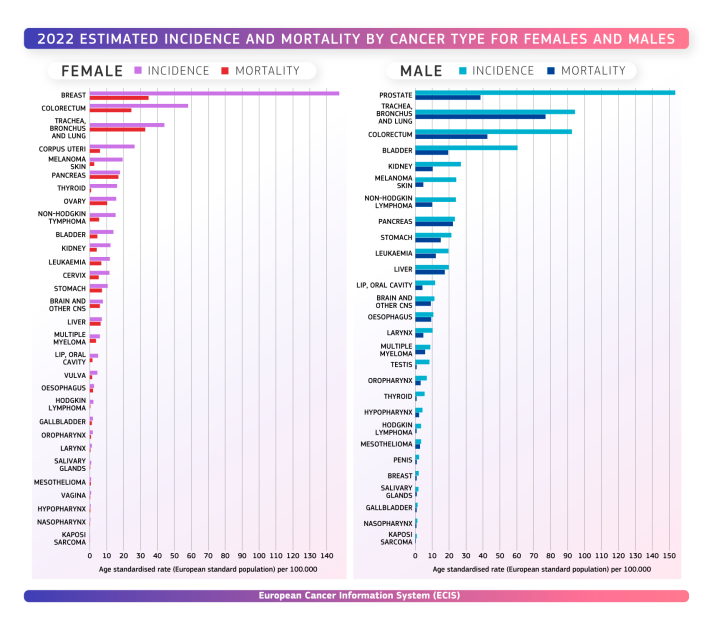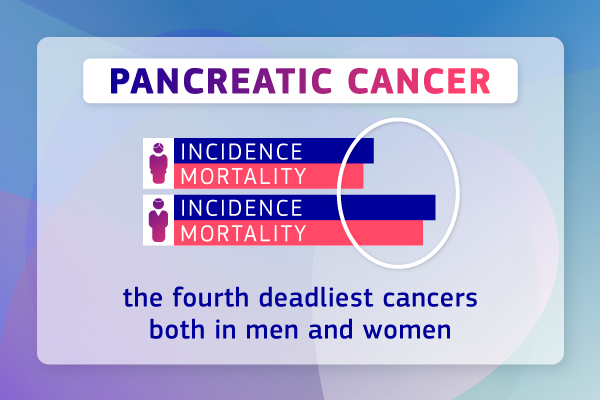
Men more at risk
New 2022 estimates for EU Member States show that 31% of men and 25% of women are expected to be diagnosed with cancer before reaching the age of 75 years. 14% of men and 9% of women are estimated to die from cancer before reaching 75 years.
Cancer affects men slightly more than women: 53% of new cancer cases and 55% of cancer deaths occur in men.
What are the most common cancers diagnosed and what cancers cause most deaths?
Breast cancer remains the most diagnosed cancer in the EU, with an estimated 380,000 cases (99% of these affecting women) which constitutes some 13.8% of all cancer diagnoses. This is followed by colorectal (356,000; 13% of all new cases), prostate (330,000; 12.1%) and lung cancer (319,000; 11.6%).
The four most common cancer causes of death in the EU are estimated to be lung (19.5% of all cancer deaths), followed by colorectal (12.3%), breast (7.5%), and pancreatic cancer (7.4%).
The challenge of pancreatic cancer
Although pancreatic cancer has a lower incidence compared to many other cancers (it ranks 8th among men and 5th among women), its low survival rate places it among the top four deadliest cancers both in men and women.
Late diagnosis and treatment are two major challenges in addressing pancreatic cancer. Considering the low and unchanging survival rate and the stable or increasing mortality trend, a growing number of deaths is expected due to the ageing of the European population.
Geographical variations across the EU
Higher incidence rates are recorded in Western and Northern EU countries (more than 640 new cases per 100,000 people), while higher mortality rates are observed in Eastern EU countries (more than 300 deaths per 100,000 people).
These geographical differences can be shaped by the prevalence of key risk factors for specific cancers; the effective delivery of national cancer control plans; the effective implementation of cancer screening programmes for breast, cervical and colorectal cancers; as well variations in diagnostic practice.
New recommendations on cancer screening
Recently, the European Commission presented a new approach to support Member States to increase their uptake in screening programmes. It aims to reach the target set in Europe's Beating Cancer Plan to offer breast, colorectal and cervical cancer screenings to 90% of those who qualify, by 2025. It should also be considered to extend screening should to include prostate, lung and gastric cancers, based on further research.
Preventing cancer being one of the four objectives of the EU Mission on Cancer, supporting research and innovation into better screening technologies, methodologies and programmes is crucial to strengthen early detection.
Our new cancer estimates show that these six cancer types account for 54.2% of all new cancer cases and 50.2% of cancer deaths in the EU in 2022.
Why do we present estimates and not timely statistics?
Delays in reporting cancer diagnoses affect timely cancer statistics: this is the reason why the number of new cancer cases need to be estimated for the most recent years.
The national estimates are the outcome of a collaborative project between the European Commission and the International Agency for Research on Cancer (IARC), the specialized cancer agency of the World Health Organization. The estimates for 2022 are based on timely recorded data from European population-based cancer registries. They will be incorporated into IARC’s global update of incidence and mortality in 185 countries/territories in the Global Cancer Observatory later this year.
Cancer may seem to strike EU citizens randomly, but there is clear variation across geographical areas between the number of new diagnoses and deaths due to cancer. Up-to-date quantification of such differences supports Member States and Associated Countries in setting priorities for national cancer control programmes and research, and is a valuable and transparent information source for citizens.
Details
- Publication date
- 2 October 2023
- Author
- Joint Research Centre






